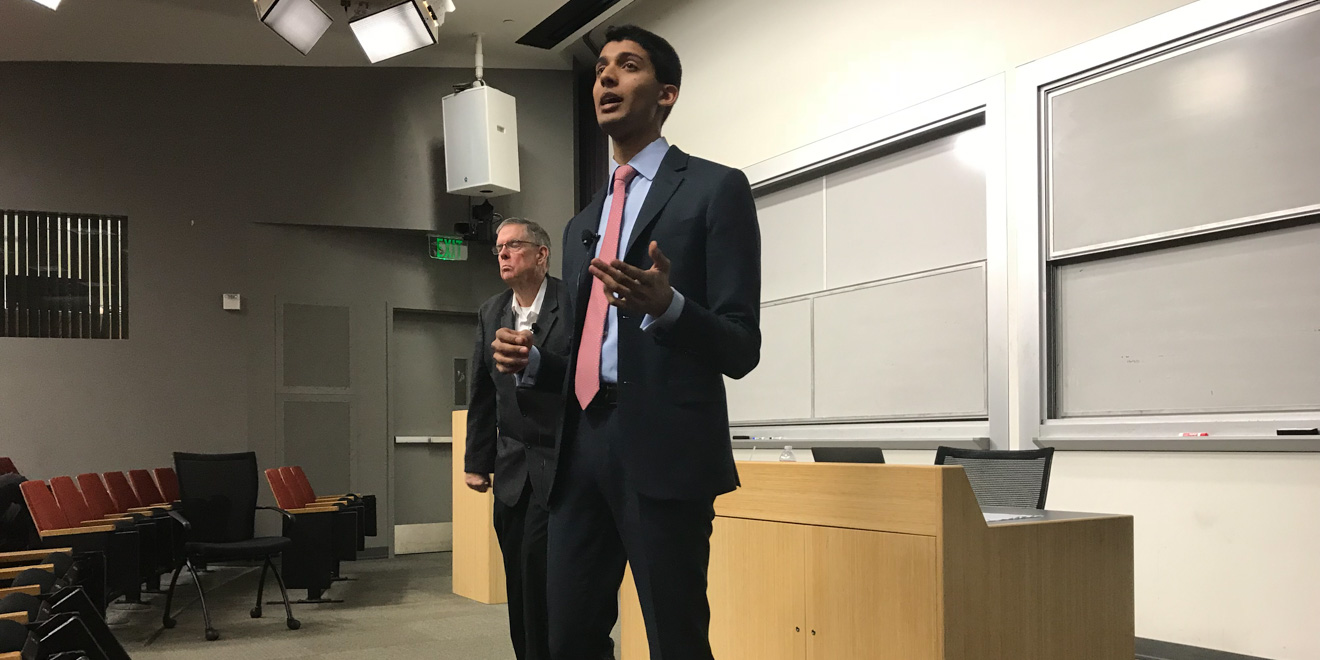In a Monday, April 2 afternoon presentation on his new book, “Taming the Sun: Innovations to Harness Solar Energy and Power the Planet,” Varun Sivaram ’11 stressed current constraints on solar power and three types of innovation — financial innovation, technological innovation and systemic innovation — that he believes are key to sustaining solar energy’s rise to dominance.
The seminar marked the first of the one-unit course MS&E 494: The Energy Seminar and was hosted by management science and engineering professor John Weyant, the faculty coordinator of the course.
Sivaram majored in physics and international relations at Stanford and is now an advisory board member for Stanford’s Woods Institute for the Environment, as well as Stanford’s Precourt Institute for Energy. Throughout the presentation, he thanked multiple members of the Stanford community in the audience, including his former adviser and other collaborators.
The seminar began with a YouTube video of Sivaram summarizing his book’s focus on what he sees as cracks in solar energy’s foundation and how they might be fixed through innovation. Afterward, Sivaram presented data on worldwide use of solar power over time in order to back up his claims before taking questions from the audience.
“In contrast to energy-dense fossil fuels, solar is diffuse, it is intermittent and volatile, and for 3,000 years humanity has attempted to harness the sun’s energy with quite minimal success,” Sivaram said. “But now we appear to be at a tipping point, and countries around the world are now seeing solar as a viable way to increase the proportion of clean, secure and affordable energy in their mix.”
Still, Sivaram expressed concerns regarding solar energy’s future. He said that the graph of solar energy usage could either follow an exponential trajectory or taper off, forming an ‘s’-shaped curve, indicating logistic growth. In the case of logistic growth, Sivaram said solar energy’s growth may completely halt due to lack of incentives to invest.
“Unless we proactively invest in those three kinds of innovation, financial, technological and systemic, this trajectory could turn into an s curve, and that ‘s’ curve could be catastrophic,” Sivaram said. “If we get to that s curve, it will already be too late.”
Specifically, Sivaram said he sees similarities between the recent rise of solar energy and that of nuclear energy in the 1900s. He warned that silicon solar panels may become a culprit in the phenomenon known as technology lock-in, by which a first-generation technology’s popularity may result in neglect of a more efficient, next-generation clean energy technology, preventing the latter’s rise.
“By and large, in recent decades, [Silicon solar cell efficiency] has stayed put,” Sivaram said. “It’s getting close to its effective efficiency ceiling.”
In contrast to that of silicon cells, the efficiency of perovskite cells, named after the perovskite structured compound contained in each cells’ light-harvesting layer, is rapidly increasing. The first perovskite cell was created in 2009, but the cells’ relatively cheap and simple manufacturing process has supported their sharp rise in efficiency.
Sivaram claimed that perovskite solar cells represent the future of solar technology due to their versatility – according to him, they can be flexible, colorful, semitransparent and efficient.
Sivaram said he believes proliferation of photovoltaics will coincide with increased use of concentrated solar power, which relies on mirrors to reflect the sun’s rays toward a heat engine. The thermal energy transferred to the heat engine facilitates electricity generation.
He also said it’s possible that solar energy might produce not only electricity but also fuels in the distant future, though storing solar power remains a relevant challenge.
“Batteries still aren’t very good at storing energy for more than a few hours, and solar is intermittent over the course of days, weeks, months, seasons, there are a whole lot of storage requirements, and there are a whole lot of technologies to achieve that storage,” Sivaram said. “Batteries are just one of them.”
Sivaram praised China’s role in decreasing the cost of solar panels through mass manufacturing, but he said that the “silicon behemoth” of an industry in China could threaten the rise of other promising materials like perovskite. In response to this threat, Sivaram posed the idea of “silicon-perovskite tandem” cells that utilize both silicon’s efficiency and perovskite’s ability to harness parts of the solar spectrum outside silicon’s range of capture.
In terms of policy, Sivaram said he was “thrilled” last week when President Donald Trump signed a bill increasing funding for solar energy research and development by 16 percent. However, Sivaram also said that tariffs by both the Obama and Trump administrations have not done the solar energy sector any favors.
“We need to keep [up the funding] because if we don’t, China is going to eclipse the United States in terms of its leading role in energy innovation,” Sivaram said.
Contact Holden Foreman at hs4man21 ‘at’ stanford.edu.
